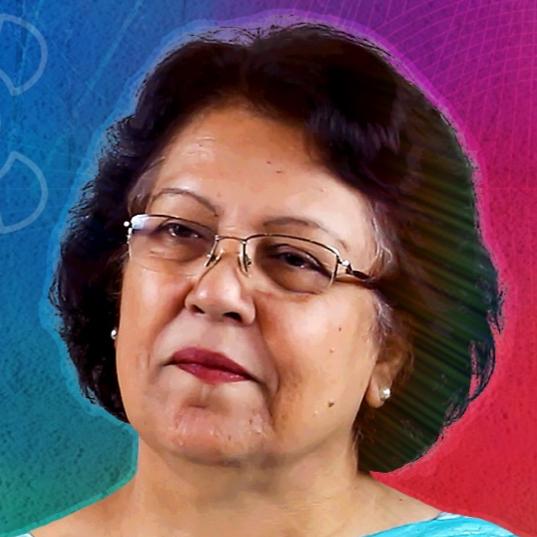
The Enchanting World of Urdu Words
Written by Azra Naqvi in Urdu
Translated by Rajat Kumar
There is hardly any language that does not borrow words from another language. Regardless of the trajectory that history follows, language and words, like genuine trustees, lead us towards the true story of the past. Linguists have long been following the traces of words which have voyaged around the world and have successfully camouflaged themselves in other languages. In Urdu, there is a huge treasure of such words which are known as ‘DaKHiil’. In fact, there is another treasure which is even bigger than that of DaKHiil words. Interestingly, these new words have appeared in new garbs with variations in meaning, pronunciation, and spelling. A lot of these words are such where a root word combines with the grammatical rules of another language. This results in the appearance of a new word. For example, the Persian word “rang” was combined with the Arabic grammatical root “t” to make the Urdu word “Rangat”. Similarly, the Arabic pluralization when combined with the Persian ‘Dih’, gave birth to ‘Dehaat’. In the same manner, there are countless other examples. Probing them further could be quite addictive. So, let us get together and witness the ever-changing colorful world of Urdu words.
Nastaleeq
Nastaleeq is a beautiful script in which Urdu is written. This was designed in Iran in the fourteenth and fifteenth centuries. While ‘naskh’ is the script in which Arabic is usually written ‘taaleeq’ is a Persian script. Both of them were merged to become Nastaleeq. It is interesting to note that in Urdu the word Nastaleeq is also used for a cultured, well mannered and refined person.
Ustad
The word ‘Ustaad’ entered the Urdu language from Persian. Its journey began with the Zoroastrian religious text Avesta which was written in the ancient Iranian language but there were not enough people who could understand it. The one who understood Avesta was known as ‘Avesta-ved’. The word ‘ved’ is still used for ‘Hakim (wise)’, or ‘Daanaa (learned)’.
Gradually, the word first became ‘Avesta-ved’, and then morphed into ‘Ustaad’. Originally, the word was used only for those who understood religious texts but later it became an appellation for one who taught and tutored. Nowadays, a master of an art, or a skill, is referred to as Ustaad too. The word has become an inseparable part of the names of the virtuosos of Indian classical music. Today, in everyday speech, the word has taken a new meaning and now being artful has come to be known as Ustaadi dikhaana. Endearingly, friends too address each other as Ustaad these days. In Indian films, characters of all sorts are depicted as Ustads, and films named ‘Ustadon ke Ustad’, ‘Do Ustad’, and ‘Ustadi, Ustad Ki’ also exemplify this.
Shagird hain hum ‘Meer’ se ustaad ke ‘Rasikh’
Ustaadon ka ustaad hai ustaad hamara
Shaakh
The word ‘Shah’ or king is closely related to the horns of animals. In Persian, the word ‘ShaaKH’ is also used in the sense of horns, while primarily it means the branch of a tree, or anything that stems forth from something else.
Gar yahi rona hai aage dekhiye kya gul khile
Shaakh phutegi Khudaaya halqa-e-zanjir mein
But the relationship between the word ‘ShaaKH’ meaning horns, and ‘Shaah’ meaning King began in the days when man lived in the forests, hunted animals to satiate his hunger, and rejoiced by adorning animal horns over his head. In ancient Iran, it was customary for local chiefs to wear ‘ShaaKH’ or horn on their heads. Then people began addressing these chiefs as Shaakh, and gradually, the word morphed into Shaah. It could also be possible that the custom of wearing crown sprung from this very ritual. Whatever the case might be, the universe of words is really fascinating.
Musavvida
In Urdu, a manuscript or an initial draft of a book is called ‘Musawwada’ or ‘Masauda’- a word strangely related to the color black. But how? In Arabic, the color black is called ‘Aswad’. Since in those days, black ink (Siyahi) made from a lamp’s collyrium, was used in writing, the word came to be used in the sense of writing. The word Musawwada, meaning ‘blackened’, came to be used in the sense of writing. Even in everyday speech the phrase ‘Kaghaz Kalaa Karnaa’ is common. But the color black is also considered a symbol of evil, misfortune, and mourning, and can be found in Urdu poetry in countless idiomatic expressions. Thus, the archaic Persian word Raushnaaii, or writing ink, too, finds its usage in Urdu.
Yaqeen hai ki andhera faqat andhera hai
Siyahi kali sahi raushnai hai phir bhi
Daftar
In Urdu, the word ‘Daftar’ means an office or a work-place. This word has entered the Urdu language from Persian, in which it means an account book; a register; a roll. These very meanings are found in the archaic Arabic language too. The word is found in its original meaning in classical Urdu poetry and prose as well. Thus, we have our old Urdu proverb, ‘Shikayato.n kaa Daftar Kholna’, or, to lay open the register of complaints. Gradually, the place where these account-books were kept came to be known as Daftar, and, people, in all directions, started frequenting it every day. Linguists opine that the word has been adapted from the Greek word ‘Dipthera’, which means leather, upon which people in that age used to write.
Jalsa
‘Jalsa’ and ‘Juluus’ are two of the most commonly used Urdu words. Their roots lie in the three-letter Arabic word ‘Jals’.
In Arabic, Juluus (Procession) means to sit, but as this word entered Urdu it got up and started walking, and along with it many people started walking and chanting slogans. But the word Jalsa (meeting) became prevalent in Urdu in its original Arabic meaning- for people to gather and congregate. Interestingly, the word ‘Jalsa’ can also be found in other regional Indian languages such as Gujarati, Marathi, and Tamil where it is used in the sense of merriment and entertainment, and Bengali in the sense of celebration.
Jalsa also happens to be the name of a famous Bengali TV channel. Satyajit Ray’s directorial venture, which was based on a famous Bengali novel, was also named “Jalsa Ghar”.
Tamasha
The word ‘Tamasha’, so to speak, has entered the Urdu language from Persian, but its root is the Arabic ‘Tamashi’, which means ‘for people to come together and walk on foot’. Since people usually go for leisurely walks together the word came to be used in the sense of amusement and diversion in everyday speech. In Persian, the word became ‘Tamasha’ and from there it was incorporated into Urdu with its poetic traditions. In our poetry, ‘Tamasha’ has been used in two senses; one, a state of commotion (Hangama); two, a spectacle seen by people with immense surprise and interest. Ghalib’s famous couplet, makes the fullest use of this double-edged word:
Jama karte ho kyun raqeebon ko
Ik tamasha hua gila na hua
The famous Marathi folk theatre in which songs and dances are performed is also called ‘Tamasha’. And, in Tamil, ‘Tamash’ means ‘humor, or, amusement’. In Malayalam, the word ‘Tamaasa’ is used for joking or jesting.
Kaahkashan
The word ‘Kah-Kashaa.n’, or, Milky-Way, has been used quite beautifully in Urdu poetry. This famous couplet is etched in everybody’s memory:
Inhin pattharon pe chal kar agar aa sako to aao
Mire ghar ke raaste mein koi kahkashan nahin hai
Interestingly, this word, which is also written as ‘Kaah-Kashaa.n’, literally means to pull dry grass on the soil. This word is made of two Persian words, ‘kah’ meaning dried grass, and ‘kashan’ meaning pulling. Similar to the marks left by a bundle of dried grass dragged on wet ground is the cluster of stars that appear in the night sky, consequently giving it the name ‘Kah-Kashan’. In Hindi, it is known as ‘Aakash-Ganga’, a word which flashes so very often in Urdu poetry.
Naa-Khuda
In Urdu, the word ‘Mallah’ means a sailor or mariner. The word finds its roots in the Arabic word ‘Milh’, meaning salt. Since seawater is salty, those who made salt from the sea were originally called Mallah. Later, those who frequented the sea came to be known as Mallah. And now, boatmen of sweet-water lakes are referred to as Mallah, too. The word ‘Malahat’, quite common in Urdu literature, is also related to ‘Milh’, it means being salty, sallow, or beautiful. Poets have brought out different shades of this word in various couplets.
Another word which is very common in Urdu poetry, and related to boat and water voyage, is NaaKhuda’. It is a combination of two words ‘Naav (boat)’ and ‘Khuda (Lord)’, and comes from Persian which means the Lord of the boat or captain.
Tumhin to ho jise kahti hai nakhudaa duniyaa
Bacha sako to bacha lo ki doobta hoon main
Shatranj
The story of the journey of words is very strange. Where a word starts and how it reaches us is really interesting and enlightening. The ancient Indian army consisted of infantry, cavalry, elephants and chariots. That is why it was called Chatrunga in Sanskrit. ‘Ang’ means organ and ‘Chatur’ means four. When a game was invented based of two armies, it was called ‘Chatrang’. The word entered in the form of ‘shatrang ‘ in Persian and was transferred from Persian to Arabic as ‘shatranj’ and the same name is being used in Urdu. Its name in Europe was derived from one of its pawns, shah or sheh ( chess)and how it changed its form in different European languages is yet another story.
The square-clad cloth used for playing chess is called ‘Bisaat’ in Urdu. You will find it interesting to know that in traditional north Indian families women used to make bed spreads in the style of two colored square boxes of shatranj , which were called shatranji . Traditionally, squares of red ‘tool’ cloth and ‘gazi’ i.e. white cotton cloth were sewn together to make a beautiful bed spreads or deewan cover.
NEWSLETTER
Enter your email address to follow this blog and receive notification of new posts.




